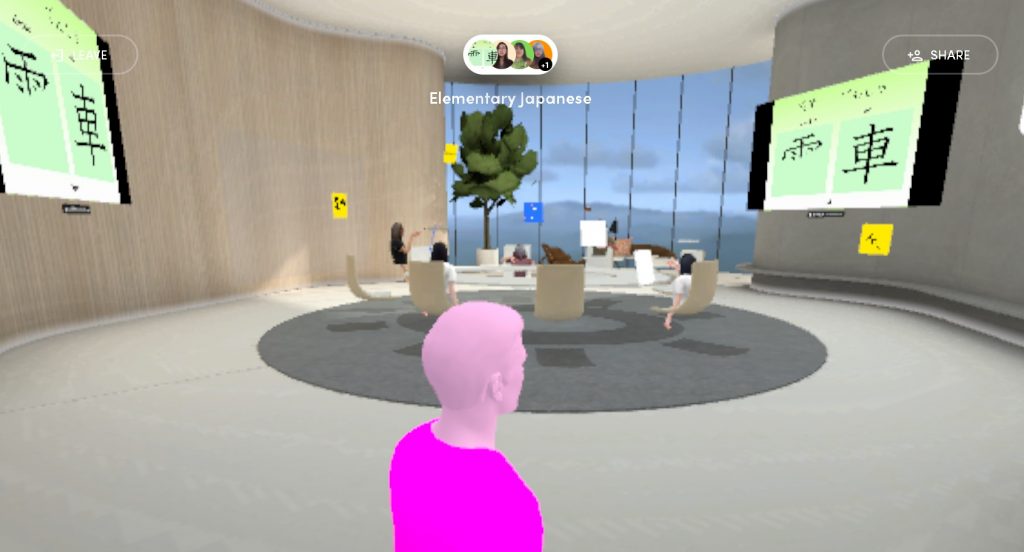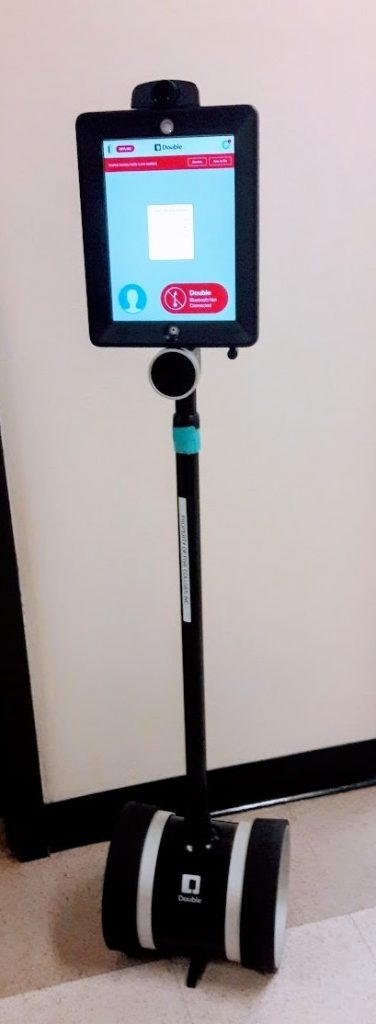Technology in Japanese Language Education
One of my current research projects aims to investigate the possible and best use of Virtual Reality (VR) to teach a foreign language in remote and in-person settings. The major objective is to provide students an opportunity to visit Japan and to learn Japanese in the VR world that is similar to face-to-face environments.
The application “Wander” virtually takes you anywhere in the world. You can walk around streets and visit historical places in Japan virtually. Another application “Workrooms” allows you to create a virtual face-to-face classroom where you can handwrite on a blackboard, arrange a table setting, and project anything from your computer. The use of avatars allows you to show up in class in any appearance regardless of their gender, race, and age. (Project run: 2021-current)
Another line of my research involves language education in the field of human-robot interaction (HRI) and robot-assisted language learning (RALL). My research currently uses a telepresence robot which helps in creating a simulated environment of face-to-face communication by remotely controlling the movement of the robot. The use of the robot allows either an instructor or a student who cannot be in class face-to-face to participate via the robot and to communicate with others as if they are physically present. It differs from videoconferencing in its mobility—the person who communicates as a robot can walk to the student(s) in class. The research focuses on the effective use of robots in human communication, particularly in the paradigm of foreign language learning, and the possibility of extending such use to people with a physical disability. (Project run: 2017-current)
We use videoconferencing to connect with multiple colleges or with individual students who cannot participate in class face-to-face. We currently use Zoom software, which allows text chatting along with videoconferencing, screen sharing, and use of a document camera in combination. The goal of the research is to find the best balance of technology use in the classroom in order to meet students’ and instructors’ needs. (Project run: 2016-2018)
Extensive Reading
My research focuses on the practical and empirical aspects of extensive reading as a method for teaching Japanese as a foreign/second language. The former focuses on how to run a credit-based course in pedagogically effective ways with in-class activities and assignments that are designed to develop learner autonomy. The latter examines the effective ways to measure the outcome of extensive reading in Japanese as a foreign/second language, such as the improvements in reading comprehension and reading fluency.
Extensive reading is one of the recommended methods for learning a foreign/second language as it facilitates a vast amount of natural input in the target language. As the word “extensive” indicates, learners are expected to read as many books as possible. The key component of successful extensive reading is to read at the comfortable language difficulty level—that is, the point at which learners don’t rely on using a dictionary to understand the contents. Reading without a dictionary helps learners pay attention to contents in a natural fashion, while it also helps them to read faster without stopping at every novel word they encounter. Using a dictionary too often slows down the learners’ overall reading time, which ultimately reduces the amount of input. An important requirement of extensive reading is to read for pleasure. Learners are expected to choose books they want to read on their own through which to learn and study Japanese language. When learning takes place for pleasure, learning takes place more effectively.
Language Processing and Fluency
Psycholinguistics is another area of my research. We analyze the linguistic complexities and cross-linguistic differences in learning and processing a second language. Many adult learners are aware of how difficult it is to comprehend and speak in the target language in the same way they do in their first language. Factors influencing such difficulty include age, memory, learning environment, input/exposure, motivation, first-language interference, and linguistic complexity. Word order plays the major role in sentence interpretation in English while case-marking particles play the major role in Japanese. However, the case-marking particles and the subject/agent are often dropped in casual speech, in which case the important cues that indicate the subject/agent in a sentence are missing. My research focuses on what kind of hidden linguistic cues people use to interpret sentences in Japanese.
The research extends to examining the development of fluency and the factors that enhance speech and reading fluency. Fluency is often discussed in language output, particularly in speech production, whereas it also matters in reading because reading includes multiple cognitive processes such as text decoding, sentence comprehension, and interpretation from bottom-up and top-down processing. My research looks at the differing types and optimal quantity of input, exposure, and practice that help learners improve their fluency, and the relationships among these factors.













